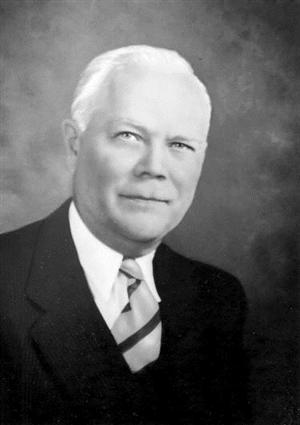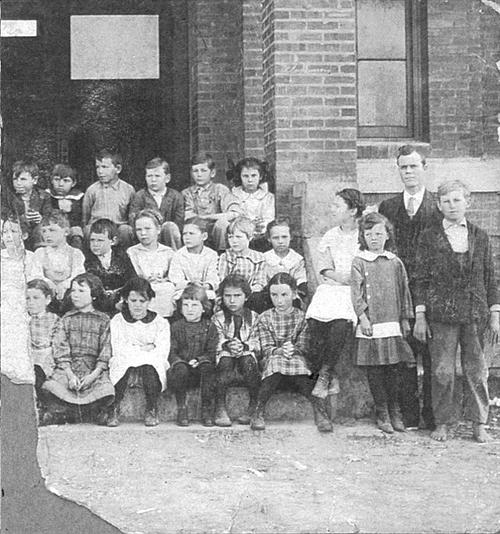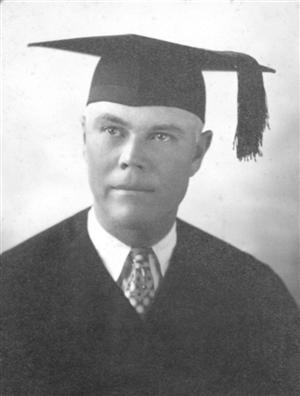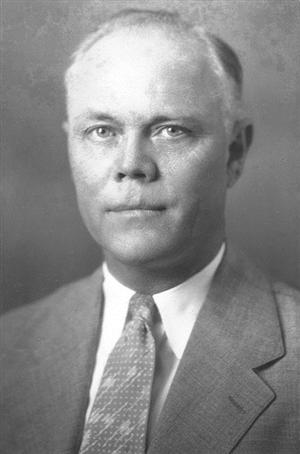-
History of Charles Emery Barrick
C.E. BARRICK’S ANCESTRY
C.E. Barrick’s great grandfather was Frederick Barrick who wasborn in 1792 and married Mary Iler. Frederick’s son, PeterBarrick, who was C.E. Barrick’s grandfather, was born inPennsylvania in 1816 and married Margaret Patterson. The Barrick Familyleft Pennsylvania and moved to Ohio for a while and then in 1856 theywent to Indiana by wagon. Two years later Andrew Jackson Barrick wasborn in 1858. He later married Sena Nixon and they were the parents ofCharles Emery Barrick.
CHARLES EMERY BARRICK IS BORN
Charles Emery Barrick was born June 21, 1881 in Clay County, Indiana.His father, known as Jack, and mother, Sena, had nine children andlived in Harrison Township, which was near Coal City, Indiana.Unfortunately, his mother, Sena, died in the early 1890s before he wasin his teens. This left his father a widower with a large family tosupport as a Mine Inspector. C. E. Barrick’s siblings werebrothers: Oliver, Marshall, Dewey and Fred who died at 15. His sisterswere Margaret (Maggie) Crist, Nellie Bridges, Edna Gilbert and Mary whowas unmarried.
C.E.BARRICK AS A YOUNG MAN
As a young man, Emery, as he liked to be called, was determined not tofollow his kinfolk who worked in the coal mines. Instead, he made aliving as a clerk in Cheney’s Mercantile store in Coal City,Indiana. He was a man of many talents as he repaired shoes, made stovepipes, and sold goods in the store. He also became an expert harnessmaker which was necessary in those days when horses were used to pullcarriages and wagons before the automobile came to this small town.Emery was a studious man and enjoyed reading with a passion. He decidedhe was well suited to become a school teacher. He attended what thenwas called a “normal school” most likely in Terra Haute,Indiana. Here he graduated after two years with a Teacher’sCertificate and started teaching school in Coal City. In education hefound a life-long calling.
Along with the other talents mentioned, Emery had a strong singingvoice and he learned to be a song leader at the local Church of Christunder the tutelage of Isaiah Harris who was a school teacher andfarmer. Later Isaiah became the County Tax Assessor. The exactcircumstances are not known, but before long, Emery married IsaiahHarris’ daughter, Hester Idella Harris, known as Della, who wasalso a member of that church. They were married June 2, 1901 in Brazil,Indiana, a larger town not far away. Emery was twenty at this time andDella was twenty-two. They settled down in Coal City and a year latertheir first son was born. He was named Dale Larimore Barrick after aChurch of Christ preacher. Dale described Coal City in this way,“It wasn’t much of a town with a few businesses, a church,and a school. Maybe a couple hundred people lived there including theones who lived on nearby farms. We lived in a nice one-story house withno electricity and no plumbing. We used an outhouse disguised by agrape arbor that was nearby. Maple trees were also near the house andThe Barrick family used the sap to make syrup and maplesugar.”
In 1905 Emery and Della had their second child, a girl named MadgeDeering Barrick, who was named after the preacher’s wife. Sinceteaching school was not well paid in Coal City, Emery continued to workat the Mercantile store on weekends. He made Dale a small wagon thatwas a model for the large wagons sold at the store. He also made alittle stove that was a model of one sold at the store. This littlestove was used for pretend “cooking” that Madge did as ayoung girl in a playhouse made for her in the yard. The children alsohad fun with a pet goat named Nanette for which Emery had made aharness.
C.E.BARRICK MOVES TO TEXAS
Times were hard back then and not many opportunities were available foryoung men in small towns. There came a time Emery heard of a job inPearland, Texas as a principal. Emery and Della had heard of a landdeal in Texas and went on a developer-sponsored train trip in 1910 tocheck it out. Evidently they liked Texas enough to make the bigdecision to move. In 1911 they and all their worldly possessions movedon the train to Pearland, Texas. Pearland was another small town onflat land between Galveston and Houston. The weather there was muchwarmer than Indiana, especially in winter.
Emery was pleased to be hired as a Teacher-Principal at the PearlandSchool. He had the reputation as an outstanding teacher, of all ages,but preferred teaching the older students. The Barrick family lived ina two-story white frame house on the upper floor. The lower floor wasthe Pearland Post Office. It was in this house that Emery and Della hadtheir third child, Nolan Ellmore Barrick in 1913. In Pearland, TheBarrick family and some friends had founded a Church of Christ. BothEmery and Della taught Sunday School and were leaders in the church.Frequently Emery filled the pulpit and became a popular lay preacherknown as a Bible scholar and effective speaker. The Methodist Churchoften dismissed their service when Emery was preaching and members camedown the street to hear him speak. Lois Bundy of Pearland writes,“C.E. Barrick with his preaching abilities was a soft spoken,mild mannered man whom everyone in the community loved andrespected.”
Although they loved their life in Pearland, Emery was always lookingfor advancement in his career and to better support his family. When anopportunity came up in the “big city” of Houston, TheBarrick family moved there in 1915. They moved into another two-storyhouse near downtown at 308 McKinney. This is the spot whereHouston’s Heritage Park is at present. Emery accepted a teachingjob in Houston and soon became a principal. During this time near thecenter of downtown, The Barrick family helped to found the CentralChurch of Christ. Emery was very active as song leader at times and asBible Teacher, Elder, and lay preacher. This early church group met inthe old City Auditorium in the Banquet Room.
C.E. BARRICK FURTHERS HIS EDUCATION
In 1917 The Barrick family moved to a home on Alston Street in theHouston Heights and a year later bought a home at 1235 Rutland in theHeights where they lived for many years. After being at HelmsElementary School and then at Harrisburg High School, Emery found thatadvancement would be easier if he completed more personal education. Hereceived his B.A. degree in 1928 from Sam Houston State Teacher’sCollege and was elected President of the Student Body his senior year.In about 1931 he was made the Principal of Luther Burbank School, alarge new school on Tidwell Road in north east Houston. It was acombination elementary school and junior high with vocationalagriculture as part of the program. This was a very nice promotion andhe loved his school as well as working with the community. Emerycontinued his education with graduate work in Austin at the Universityof Texas in the summers and received his Master’s degree in 1934.He always stressed the value of education and that people should makesomething of themselves. Listening on the radio to Classical music wasanother hobby of his as well as reading his books and studying theBible. He remained active in the church which had moved to Drew andAlbany Streets, but it retained the Central Church of Christ name.Later the church moved to Montrose Boulevard and built a fine, brickbuilding which still stands today as a Branch Library for the HoustonPublic Library.
C.E. BARRICK’S FAMILY
In 1932 Emery and Della became grandparents for the first time. Theirdaughter, Madge, and her husband, Jesse Madden, had a baby girl namedBarbara Dell Madden. Both Madge and Jesse had followed in Emery’sfootsteps and had become teachers on graduating from Rice in 1927.Jesse Madden later became a principal and Madge taught for 43 years inthe Houston Independent School System. Madge and Jesse also had a sonnamed Barry E. Madden who became a dentist in Houston. Their daughter,Barbara, also became a teacher years later after her marriage toRichard Chapman. Emery’s son Nolan was in education as well,following the family tradition. After graduating from Rice and servingin the Navy as a lieutenant he became an Associate Professor ofArchitecture at Iowa State University and later at the University ofTexas. In 1953 Nolan moved to Texas Tech University as Chairman of theArchitecture and Allied Arts Department. He became Dean of Architectureat Texas Tech and retired in 1979. Emery’s older son, Dale, had asuccessful military career serving in the U.S. Army and reaching therank of Lieutenant Colonel. Dale and his wife Bebe had two sons, HarleyBarrick and Noel Barrick. Nolan and his wife Rosemary adopted twochildren, Bruce Watkin Barrick and Anne Hester Barrick.
When Emery’s two sons went off to fight in World War II in 1941,neither realized they would never see their father again. He died ofcancer August 14, 1942 at his home on Rutland Street. He was only 61– far too young to die. It was a terrible loss to the family andto the community. In 1949 he was honored by the Houston IndependentSchool District and by the community he had served while at BurbankSchool. The newest elementary school in the area was named for him– C. E. Barrick Elementary School. It was a lovely tribute to awonderful man and was greatly appreciated by the family and all wholoved him.
This history was written in 2006 by Barbara Madden Chapman,granddaughter of C.E. Barrick, using information from Dale Barrick,Madge Barrick Madden and Nolan Barrick. Also much information came fromher grandmother, Della, widow of C.E. Barrick.




Select a School...
Select a School
- Alcott Elementary School
- Almeda Elementary
- Alternative Certification Program
- Anderson Elementary School
- Arabic Immersion Magnet School (AIMS)
- Ashford Elementary
- Askew Elementary School
- Atherton Elementary
- Attucks Middle School
- Austin High School
- Baker Montessori
- Barbara Bush Elementary
- Barbara Jordan Career Center
- Barrick (C. E.) Elementary
- Bastian Elementary School
- Baylor College of Medicine Academy at James D Ryan MS
- Baylor College of Medicine Biotech Academy at Rusk
- Bellaire High School
- Bellfort Early Childhood Center
- Benavidez Elementary
- Benbrook Elementary
- Berry Elementary
- Billy Reagan K8 Educational Center
- Frank Black Middle School
- Blackshear Elementary
- Bonham Elementary School
- Bonner Elementary
- Braeburn Elementary
- Briargrove Elementary School
- Briarmeadow Charter
- Briscoe Elementary
- Brookline Elementary
- Browning Elementary
- Bruce Elementary
- Burbank Elementary
- Burbank Middle
- Burrus Elementary
- Cage Elementary
- Career Readiness
- Carnegie Vanguard High School
- Carrillo Elementary
- Challenge Early College High School
- Clemente Martinez Elementary School
- Clifton Middle School
- Codwell Elementary
- Community Services
- Condit Elementary
- Coop Elementary
- Cornelius Elementary
- Crespo Elementary
- Crockett Elementary School
- Cullen Middle School
- Cunningham Elementary
- César E. Chavez High School
- Daily, Ray K. Elementary
- David G. Burnet Elementary
- Davila Elementary
- De Chaumes Elementary
- De Zavala Elementary
- Deady Middle School
- DeAnda Elementary School
- Distrito Escolar Independiente de Houston
- Dogan Elementary School
- Durham Elementary
- Durkee Elementary
- East Early College High School
- Eastwood Academy
- Edison Middle School
- Elementary DAEP
- Eliot Elementary School
- Elmore Elementary School
- Elrod Elementary School
- Emerson Elementary
- Energized for Excellence
- Energy Institute High School
- McGowen Elementary
- Farias ECC
- Cook Elementary
- Field Elementary School
- Fleming Middle School
- Foerster Elementary
- Fondren Elementary
- Fondren Middle School
- Fonville Middle School
- Fonwood Early Childhood Center
- Forest Brook Middle School
- Franklin Elementary
- Frost Elementary
- Furr High School
- Gabriela Mistral CEC
- Gallegos Elementary
- Garcia Elementary School
- Garden Oaks Montessori
- Garden Villas Elementary
- Golfcrest Elementary
- Gregg Elementary
- Gregory-Lincoln Education Center
- Gross Elementary
- Halpin Early Childhood Center
- Hamilton Middle School
- Harper DAEP High School
- Harris (John R.) Elementary
- Harris (Roland P.) Elementary School
- Hartman Middle School
- Hartsfield Elementary School
- Harvard Elementary School
- Health and Medical Services
- Heights High School
- Helms Elementary School
- Herod Elementary School
- Herrera Elementary School
- High School Ahead Academy Middle School
- High School for Law and Justice (HSLJ)
- Highland Heights Elementary
- Hilliard Elementary School
- Hines Caldwell Elementary School
- HISD Benefits
- HISD Human Resources
- HISD Miles Ahead Scholars
- HISD School Choice
- HISD School Website Resources
- Hobby Elementary School
- Hogg Middle School
- Holland Middle School
- Horn Elementary
- Houston Academy for International Studies
- Isaacs Elementary
- J.P. Henderson Elementary
- Long Academy
- Janowski Elementary
- Jefferson Elementary School
- John G. Osborne Elementary
- Jones Futures Academy
- Kashmere Gardens Elementary Fine Arts Magnet
- Kashmere High School
- Kate Bell Elementary
- Smith, K. Elementary
- Kelso Elementary
- Kennedy (John F.) Elementary
- Ketelsen Elementary
- Key Middle School
- Kinder High School for the Performing and Visual Arts
- Kolter Elementary
- Lamar High School
- Lanier Middle School
- Lantrip Elementary
- Las Americas
- Laurenzo Early Childhood Education Center
- James H. Law Elementary
- Lawson Middle School
- Lewis Elementary
- Liberty High School Homepage
- Lockhart Elementary School
- Longfellow Elementary School
- Looscan Elementary
- Love Elementary School
- Lovett Elementary School Fine Arts Magnet
- Lyons Elementary School
- Mabel B. Wesley Elementary School
- MacGregor Elementary School
- Mading Elementary STEM Academy
- Madison (James) High School
- Mandarin Immersion
- Marcellus Elliot Foster Elementary
- Twain (Mark) Elementary
- Mark White Elementary School
- Marshall Middle Academy of Fine Arts
- Martin Luther King, Jr. Early Childhood Center
- McNamara Elementary
- McReynolds Middle School
- Medicaid Finance & Consulting Services
- Memorial Elementary
- Meyerland Performing and Visual Arts Middle School
- DeBakey High School for Health Professions
- Mickey Leland College Preparatory Academy for Young Men
- Gulfton
- Middle College at Felix Fraga
- Milby High School
- Milne Elementary School
- Mitchell Elementary School
- Montgomery Elementary
- Moreno, Joe E. Elementary
- Henderson Elementary School
- Neff Early Learning Center
- Neff Elementary School
- North Forest High School
- North Houston Early College HS
- Northline Elementary
- Northside High School
- Oak Forest Elementary School
- Oates Elementary
- Ortiz Middle School
- Paige Elementary
- Park Place Elementary School
- Parker Elementary
- Henry Middle School
- Patterson Elementary
- Paul Revere Middle School
- Peck Elementary
- Pershing Middle School
- Petersen Elementary
- Pilgrim Academy
- Pin Oak Middle School
- Piney Point Elementary School
- Pleasantville Elementary School
- Poe Elementary
- Port Houston Elementary School
- Project Chrysalis Middle School
- Pugh Elementary
- Raul Martinez Elementary
- Red Elementary
- Redesign
- Reynolds Elementary
- River Oaks Elementary IB World School
- Roberts Elementary
- Robinson Elementary
- Rodriguez, Sylvan Elementary
- Roosevelt Elementary
- Ross (Betsy) Elementary School
- Rucker Elementary
- Sam Houston Math, Science and Technology Center
- Sanchez Elementary
- Scarborough Elementary
- Scarborough High School
- Scroggins Elementary School
- Secondary DAEP
- Seguin Elementary
- Shadowbriar Elementary
- Shadydale Elementary School
- Sharpstown High School
- Sharpstown International School
- Shearn Elementary School
- Sherman Elementary School
- Sinclair Elementary School
- South Early College High School
- Southmayd Elementary School
- Sterling Aviation High School
- Stevens Elementary
- Stevenson Middle School
- Student Supports
- Students
- Sugar Grove Academy Middle School
- Sutton Elementary
- T.H. Rogers School
- Tanglewood Middle School
- Texas Connections Academy at Houston
- Texas Education
- The Rice School La Escuela Rice
- The School at St George Place
- Thomas Middle School
- Thompson Elementary
- Thurgood Marshall Elementary School
- Tijerina Elementary
- Tinsley Elementary
- Travis Elementary School
- Valley West Elementary
- Virgil I. Grissom Elementary School
- Wainwright Elementary
- Walnut Bend Elementary
- Waltrip High School
- Washington High School
- Welch Middle School
- West Briar Middle School
- West University Elementary School
- Westbury High School
- Westside High School
- Wharton Dual Language Academy
- Wheatley High School
- Whidby Elementary
- White (Ed) Elementary
- Whittier Elementary School
- Williams Middle School
- Windsor Village Vanguard Magnet Elementary
- Wisdom High School
- Woodson PK-5 Leadership Academy
- Worthing High School
- Yates High School
- Navarro Middle School
- Young Elementary
- Young Scholars Academy for Excellence
- YWCPA







